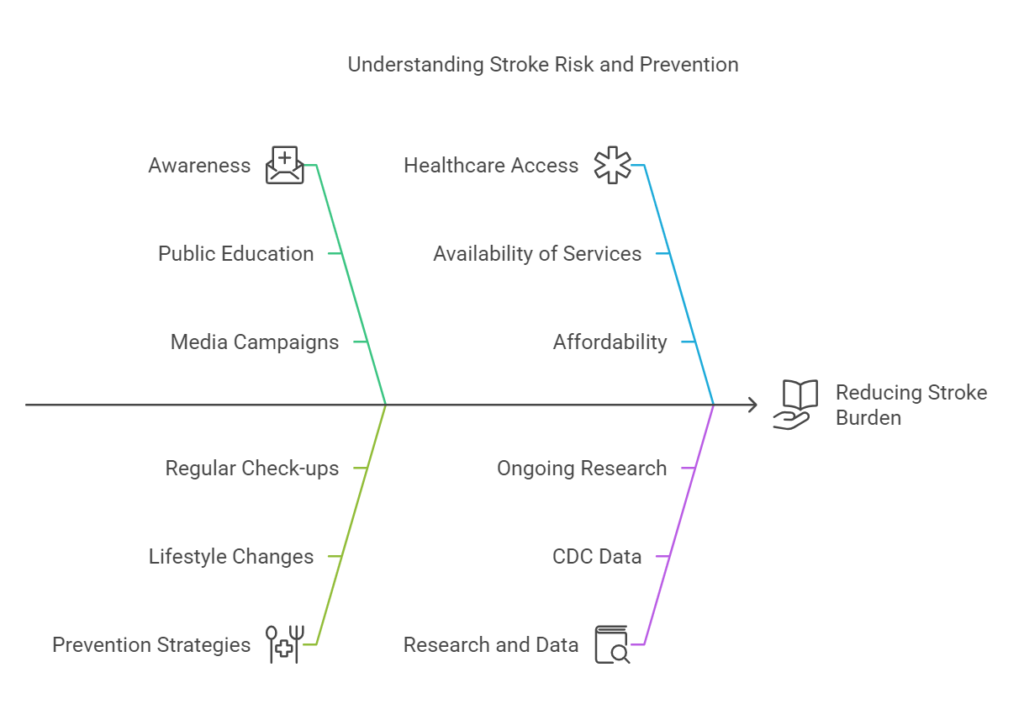Understanding Stroke Risk: Stroke Survivor Statistics
Stroke, a sudden disruption of blood flow to the brain, can have devastating consequences. While it can affect anyone, certain demographics are at higher risk. Let’s delve into the numbers to better understand this serious health condition.
Stroke Survivor Statistics by Demographic, Gender, and Age
The following table summarizes key statistics on stroke prevalence and trends in the United States:
| Characteristic | 2011-2013 | 2014-2016 | 2017-2019 | 2020-2022 | Change (2011-2013 to 2020-2022) |
|---|---|---|---|---|---|
| Age Group (yrs) | |||||
| 18-44 | 0.8 | 0.8 | 0.9 | 0.9 | 14.6% |
| 45-64 | 3.3 | 3.6 | 3.9 | 3.8 | 15.7% |
| ≥65 | 7.7 | 7.7 | 7.9 | 7.7 | 0% |
| Sex | |||||
| Female | 2.7 | 2.8 | 2.9 | 2.9 | 9.3% |
| Male | 2.8 | 2.9 | 3.1 | 2.9 | 6.2% |
| Race/Ethnicity | |||||
| AI/AN | 5.4 | 5.7 | 6.2 | 5.3 | -2.0% |
| Asian | 1.8 | 1.6 | 1.7 | 1.6 | -11.8% |
| Black or African American | 4.0 | 4.3 | 4.6 | 4.3 | 7.8% |
| NH/PI | 2.9 | 3.6 | 3.9 | 4.4 | 52.3% |
| White | 2.5 | 2.6 | 2.8 | 2.7 | 7.2% |
| Hispanic or Latino | 2.4 | 2.4 | 2.6 | 2.8 | 16.1% |
| Education | |||||
| Less than HS diploma | 4.4 | 4.7 | 4.8 | 5.2 | 18.2% |
| HS diploma or GED | 2.9 | 3.1 | 3.3 | 3.3 | 11.9% |
| Some college | 2.6 | 2.7 | 3.0 | 2.9 | 13.6% |
| College degree or higher | 1.6 | 1.6 | 1.7 | 1.7 | 5.4% |
Key Takeaways:
- Age: Stroke risk increases significantly with age.
- Gender: Women are slightly more likely to experience a stroke than men.
- Race/Ethnicity: Black adults and those of Hispanic or Latino origin have higher stroke prevalence compared to white adults.
- Education: Lower levels of education are associated with increased stroke risk.
Why These Numbers Matter
Understanding these statistics is crucial for:
- Prevention: Identifying high-risk groups allows for targeted public health campaigns and interventions to reduce stroke risk factors like high blood pressure, diabetes, and smoking.
- Early Detection: Raising awareness among high-risk populations can lead to earlier stroke detection and faster treatment, which can significantly improve outcomes.
- Rehabilitation: Data on stroke survivors can inform the development of effective rehabilitation programs to help individuals recover and regain their independence.
Taking Action:
- Know Your Risks: If you fall into a high-risk group, discuss your concerns with your doctor.
- Adopt Healthy Habits: Maintain a healthy diet, exercise regularly, and avoid smoking to reduce your stroke risk.
- Recognize Stroke Symptoms: Be aware of the signs of stroke, such as sudden weakness or numbness, difficulty speaking, and vision problems. Act FAST: Face drooping, Arm weakness, Speech difficulty, Time to call 911.
By raising awareness and taking proactive steps, we can work towards reducing the burden of stroke and improving the lives of stroke survivors.
Disclaimer: This information is for general knowledge and informational purposes only and does not constitute medical advice. Consult with a healthcare professional for any health concerns.
Note: The data presented in this blog post is based on the provided table, which likely originates from the Centers for Disease Control and Prevention (CDC).
